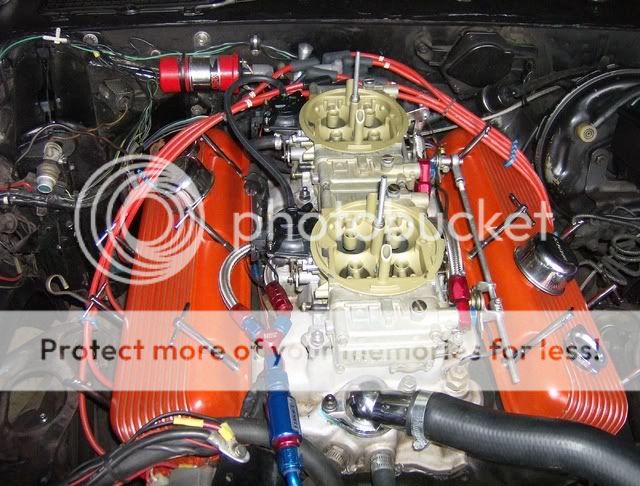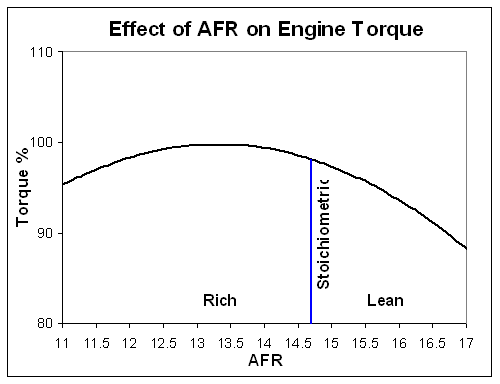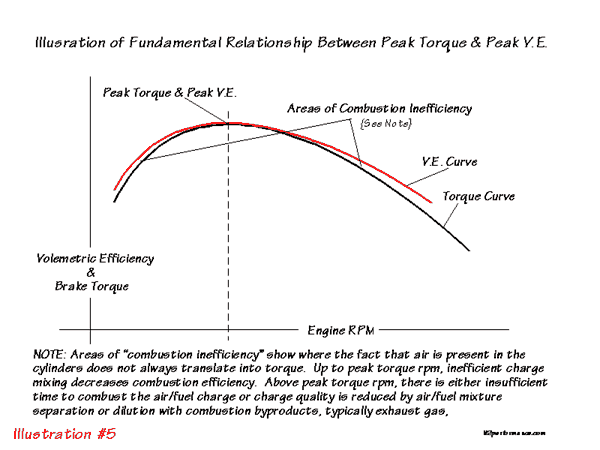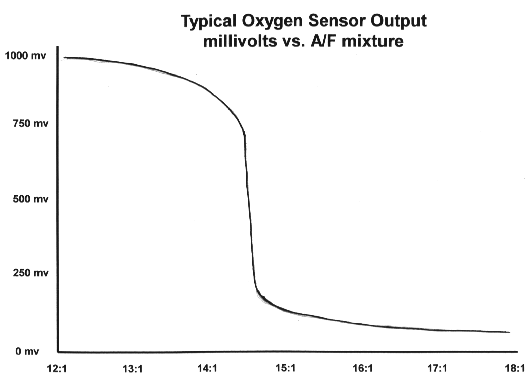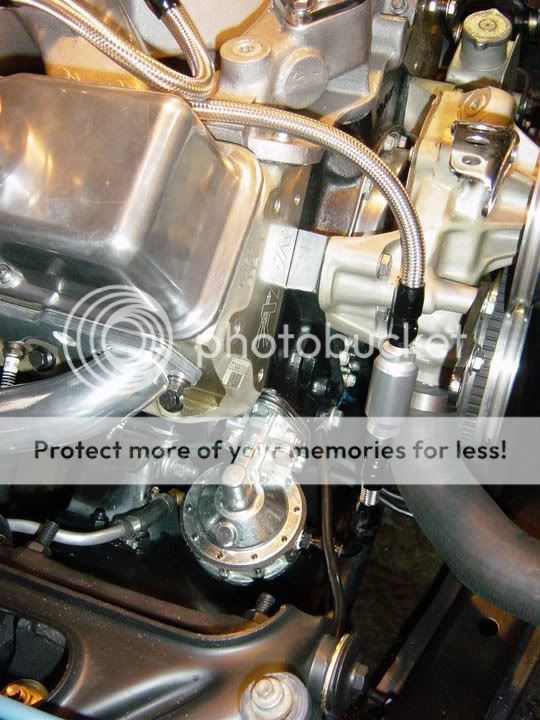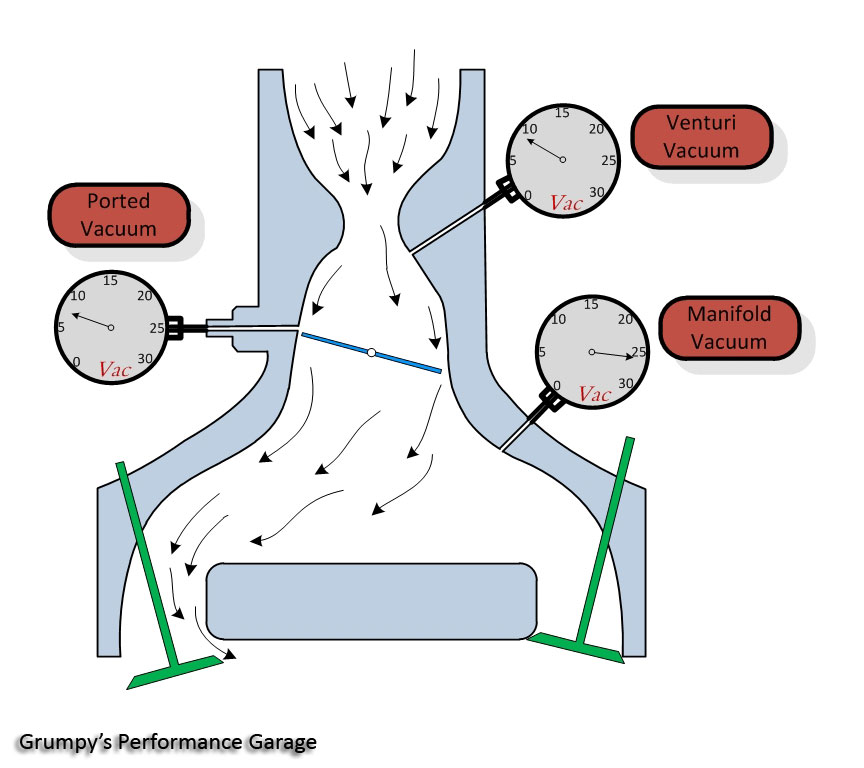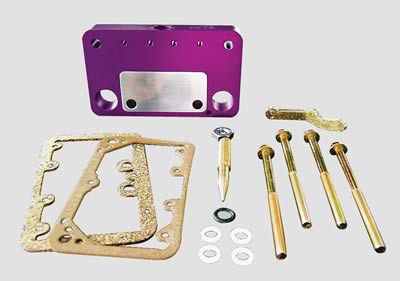I get this question in so many versions I guess its time for a thread with some basic info.
it helps a great deal to know what your working with , each carb has good and bad points

EDELBROCK
http://www.edelbrock.com/automotive_new ... manual.pdf
viewtopic.php?f=55&t=1820&p=4717&hilit=edelbrock#p4717

HOLLEY

QUADRAJET
reading the sub linked data on this site is critical to getting the full info youll need
viewtopic.php?f=55&t=1639&p=3949#p3949
the question usually goes " what size carb do I need," or something similar,
4v carbs are rated at a flow rate determined with a vacuum or pressure drop of 1.5" of mercury, your best power will generally be found with a carb that lowers the pressure drop or vacuum to between 0.5" and 1.0" of vacuum, not 1.5" at full throttle,more vacuum at full throttle indicates a slight restriction to flow, now on a street car that's not going to be much if and problem, but on a race cars engine its a sign that your potentially giving away some potential power.
lets look at your common 600cfm carb many of you guys use, a 0.5 inches of vacuum it flows only about 350cfm, at 1.0" it flows about 500cfm, at 1.5" it flows about 600 cfm , rated like a two barrel at 3.0" of vacuum it flows close to 780cfm, and if you stuck it on a 600 cubic inch big block spinning 6000rpm you'll pull about 6" of vacuum and it would flow about 1000cfm plus!
now remember you'll try to stay in the .5" to 1.5" range at full throttle, to make good power.
now some of you might notice that the flow dropped NOTICEABLY once the vacuum dropped and dropping the vacuum at wide open throttle tends to help power, provided the a/f ratio is kept near 12.7-13.0:1,AND the engine is set up to USE the flow available to it.
VOLUMETRIC EFFICIENCY
in theory a cylinder fills to 100% full, but the limited time the valves are open and the ports restrictive flow will only allow that to happen at a narrow rpm range
your engines torque curve on an rpm scale closely mirrors the engines efficincy at filling the cylinders, on that same scale, once the cam timing and port flow become a restriction power falls off because theres less fuel /air mix burnt per power stroke, the power tends to keep going up for alittle further in the rpm band simply because theres MORE ,thou slightly less effective power strokes per minute.
at 1000rpm theres 500 intake strokes per minute thats 8.3 per second times the intake valve opens and closes, at 6500rpm thats 54 times a second, not much time when you think about what needs to flow thru that port in the limited time....especially if you remember that of that 720 degrees in the cycle only about 240 degrees have any useful flow potential, so you just cut even that time by 2/3rds
keep in mind the rear gear ratio has a huge effect on the time you'll spend in each gear before being forced to change gears due to the rpm levels increasing
http://www.youtube.com/watch?v=k-Nx5HEzvlY
viewtopic.php?f=50&t=1652&p=3987&hilit=volumetric#p3987
viewtopic.php?f=38&t=1099&p=2152&hilit=volumetric#p2152
faster,and the distance you'll travel between shifts, will be shorter,it also aids in that your applying more rpms or power strokes per foot of distance traveled, thus more tq gets applied,the converter allows you to get into the more effective higher rpm ranges faster and apply the tq quicker, BOTH are necessary to take full advantage of the power curve, look heres two different power curves, it should be obvious that you'll want to both start higher and operate in a higher rpm range with the second combo than the first, to maximize the effective power to the rear wheels


now back to the carbs size
some of you may have figured out that to get the lower vacuum or restriction, you'll want a larger carb or perhaps two carbs, remember were trying to get that .5"-1.0" of vacuum at full throttle, and that 600cfm carb is not going to flow 600cfm, at that vacuum reading but between about 350-500cfm, so if you have an engine that can take full advantage of the flow it may, and usually does require a larger carb to make max power,that 383 might require an 800-850cfm carb or two 600 cfm carbs (since you double the venturie cross sectional area with two carbs the vacuum reading is generally cut to about 1/2 what it was and the two 600 cfm carbs now flow about 350cfm each or 700cfm per pair) yet the carb size is just NOT all that critical,to making fairly decent (NOT MAXIMUM POWER) simply because as the vacuum signal goes up, so does the carbs flow rate, and as the vacuum signal strength goes down so does the flow
RESPONSE!
up till now we are talking only FULL THROTTLE POWER, but you operate under a wide range of rpms and loads, put that larger carb on a small engine and it makes good power at wide open throttle, but it also tends to have a weak vacuum signal at off idle rpm ranges and it may run like crap! so a balance must be accepted. smaller carbs are generally more responsive, but slightly more restrictive with their smaller venturies.
lets look at a 383, in theory each cylinder requires 1/8 th of the displacement, or 47.875 cubic inches of fuel air mix every 720 degrees, or every other time around on the intake stroke,there's 1728 cubic inches in a cubic foot, so at 6500rpm the 383 would require 1244750 cubic inches, or 720cfm (remember the carbs are rated at 1.5" but you want lets assume .75 inches of vacuum, yet we don,t want a carb so big that response and drivability sucks, in theory we want a 800-850cfm carb at full throttle, but only a 280-400cfm carb at low rpms, that's why a 600cfm-750cfm carb is generally selected,
this is not a guessing game, having a good understanding of what your looking at and a few basic tools will provide more info,
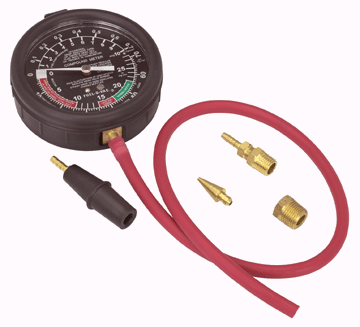
http://www.harborfreight.com/fuel-pump- ... 93547.html
throw a vacuum gauge on the plenum under the carb and run the engine at w.o.t. under load and get a reading
if its higher than about 2 inches of vacuum you might benefit from a slightly larger carb.
viewtopic.php?f=44&t=777
viewtopic.php?f=55&t=2994
but Id also point out that TWIN/DUAL 500cfm carbs will work very exceptionally
having BOTH the flow at high rpms and the small responsive venturies at low and mid rpm ranges.
but since it requires extensive tuning skills they are less commonly used/selected
remember that great set of heads that flow 250cfm at .600 lift??
well of the 720 degrees available in a cycle there's probably less than a tenth of a second to a fifty-th of a second of available time that they actually get to flow air, yet they are rated at a steady open flow, that head that flows 250cfm on a bench flows A WHOLE LOT LESS ON AN ENGINE WITH MOVING VALVES, one reason why maximizing flow potential is critical
QUESTIONS/COMMENTS
this may help you
http://users.erols.com/srweiss/calcdchg.htm
http://users.erols.com/srweiss/calccarb.htm
http://users.erols.com/srweiss/calcafhp.htm
http://www.barrygrant.com/fromBarryGran ... ual-08.pdf
http://www.innovatemotorsports.com/products/lm1.php
http://www.classictrucks.com/tech/0806c ... index.html
http://www.stockcarracing.com/techartic ... index.html
http://www.camaros.net/techref/articles/holley_2.htm
http://www.chevyhiperformance.com/howto ... index.html
http://www.rbracing-rsr.com/runnertorquecalc.html
viewtopic.php?f=55&t=1442
viewtopic.php?f=50&t=1853&p=4848#p4848
http://www.engr.colostate.edu/~allan...a/effarea.html
viewtopic.php?f=44&t=745
viewtopic.php?f=44&t=585
http://www.centuryperformance.com/tunin ... g-148.html
http://victorylibrary.com/mopar/intake-tech-c.htm
http://www.geocities.com/MotorCity/T...92/vizard.html
viewtopic.php?f=44&t=1142
http://www.bob2000.com/carb.htm
http://www.mortec.com/carbtip1.htm
viewtopic.php?f=44&t=1116
http://www.centuryperformance.com/fueli ... g-140.html
http://www.rbracing-rsr.com/runnertorquecalc.html
http://www.centuryperformance.com/vacuum.asp
BTW HERE IS THREE MORE CLOSELY RELATED THREADS WITH GREAT INFO
viewtopic.php?f=50&t=1652&p=3987&hilit=volumetric#p3987
viewtopic.php?f=38&t=1099&p=2152&hilit=volumetric#p2152
viewtopic.php?f=55&t=109&p=136#p136
it helps a great deal to know what your working with , each carb has good and bad points

EDELBROCK
http://www.edelbrock.com/automotive_new ... manual.pdf
viewtopic.php?f=55&t=1820&p=4717&hilit=edelbrock#p4717

HOLLEY

QUADRAJET
reading the sub linked data on this site is critical to getting the full info youll need
viewtopic.php?f=55&t=1639&p=3949#p3949
the question usually goes " what size carb do I need," or something similar,
4v carbs are rated at a flow rate determined with a vacuum or pressure drop of 1.5" of mercury, your best power will generally be found with a carb that lowers the pressure drop or vacuum to between 0.5" and 1.0" of vacuum, not 1.5" at full throttle,more vacuum at full throttle indicates a slight restriction to flow, now on a street car that's not going to be much if and problem, but on a race cars engine its a sign that your potentially giving away some potential power.
lets look at your common 600cfm carb many of you guys use, a 0.5 inches of vacuum it flows only about 350cfm, at 1.0" it flows about 500cfm, at 1.5" it flows about 600 cfm , rated like a two barrel at 3.0" of vacuum it flows close to 780cfm, and if you stuck it on a 600 cubic inch big block spinning 6000rpm you'll pull about 6" of vacuum and it would flow about 1000cfm plus!
now remember you'll try to stay in the .5" to 1.5" range at full throttle, to make good power.
now some of you might notice that the flow dropped NOTICEABLY once the vacuum dropped and dropping the vacuum at wide open throttle tends to help power, provided the a/f ratio is kept near 12.7-13.0:1,AND the engine is set up to USE the flow available to it.
VOLUMETRIC EFFICIENCY
in theory a cylinder fills to 100% full, but the limited time the valves are open and the ports restrictive flow will only allow that to happen at a narrow rpm range
your engines torque curve on an rpm scale closely mirrors the engines efficincy at filling the cylinders, on that same scale, once the cam timing and port flow become a restriction power falls off because theres less fuel /air mix burnt per power stroke, the power tends to keep going up for alittle further in the rpm band simply because theres MORE ,thou slightly less effective power strokes per minute.
at 1000rpm theres 500 intake strokes per minute thats 8.3 per second times the intake valve opens and closes, at 6500rpm thats 54 times a second, not much time when you think about what needs to flow thru that port in the limited time....especially if you remember that of that 720 degrees in the cycle only about 240 degrees have any useful flow potential, so you just cut even that time by 2/3rds
keep in mind the rear gear ratio has a huge effect on the time you'll spend in each gear before being forced to change gears due to the rpm levels increasing
http://www.youtube.com/watch?v=k-Nx5HEzvlY
viewtopic.php?f=50&t=1652&p=3987&hilit=volumetric#p3987
viewtopic.php?f=38&t=1099&p=2152&hilit=volumetric#p2152
faster,and the distance you'll travel between shifts, will be shorter,it also aids in that your applying more rpms or power strokes per foot of distance traveled, thus more tq gets applied,the converter allows you to get into the more effective higher rpm ranges faster and apply the tq quicker, BOTH are necessary to take full advantage of the power curve, look heres two different power curves, it should be obvious that you'll want to both start higher and operate in a higher rpm range with the second combo than the first, to maximize the effective power to the rear wheels
now back to the carbs size
some of you may have figured out that to get the lower vacuum or restriction, you'll want a larger carb or perhaps two carbs, remember were trying to get that .5"-1.0" of vacuum at full throttle, and that 600cfm carb is not going to flow 600cfm, at that vacuum reading but between about 350-500cfm, so if you have an engine that can take full advantage of the flow it may, and usually does require a larger carb to make max power,that 383 might require an 800-850cfm carb or two 600 cfm carbs (since you double the venturie cross sectional area with two carbs the vacuum reading is generally cut to about 1/2 what it was and the two 600 cfm carbs now flow about 350cfm each or 700cfm per pair) yet the carb size is just NOT all that critical,to making fairly decent (NOT MAXIMUM POWER) simply because as the vacuum signal goes up, so does the carbs flow rate, and as the vacuum signal strength goes down so does the flow
RESPONSE!
up till now we are talking only FULL THROTTLE POWER, but you operate under a wide range of rpms and loads, put that larger carb on a small engine and it makes good power at wide open throttle, but it also tends to have a weak vacuum signal at off idle rpm ranges and it may run like crap! so a balance must be accepted. smaller carbs are generally more responsive, but slightly more restrictive with their smaller venturies.
lets look at a 383, in theory each cylinder requires 1/8 th of the displacement, or 47.875 cubic inches of fuel air mix every 720 degrees, or every other time around on the intake stroke,there's 1728 cubic inches in a cubic foot, so at 6500rpm the 383 would require 1244750 cubic inches, or 720cfm (remember the carbs are rated at 1.5" but you want lets assume .75 inches of vacuum, yet we don,t want a carb so big that response and drivability sucks, in theory we want a 800-850cfm carb at full throttle, but only a 280-400cfm carb at low rpms, that's why a 600cfm-750cfm carb is generally selected,
this is not a guessing game, having a good understanding of what your looking at and a few basic tools will provide more info,

http://www.harborfreight.com/fuel-pump- ... 93547.html
throw a vacuum gauge on the plenum under the carb and run the engine at w.o.t. under load and get a reading
if its higher than about 2 inches of vacuum you might benefit from a slightly larger carb.
viewtopic.php?f=44&t=777
viewtopic.php?f=55&t=2994
but Id also point out that TWIN/DUAL 500cfm carbs will work very exceptionally
having BOTH the flow at high rpms and the small responsive venturies at low and mid rpm ranges.
but since it requires extensive tuning skills they are less commonly used/selected
remember that great set of heads that flow 250cfm at .600 lift??
well of the 720 degrees available in a cycle there's probably less than a tenth of a second to a fifty-th of a second of available time that they actually get to flow air, yet they are rated at a steady open flow, that head that flows 250cfm on a bench flows A WHOLE LOT LESS ON AN ENGINE WITH MOVING VALVES, one reason why maximizing flow potential is critical
QUESTIONS/COMMENTS
this may help you
http://users.erols.com/srweiss/calcdchg.htm
http://users.erols.com/srweiss/calccarb.htm
http://users.erols.com/srweiss/calcafhp.htm
http://www.barrygrant.com/fromBarryGran ... ual-08.pdf
http://www.innovatemotorsports.com/products/lm1.php
http://www.classictrucks.com/tech/0806c ... index.html
http://www.stockcarracing.com/techartic ... index.html
http://www.camaros.net/techref/articles/holley_2.htm
http://www.chevyhiperformance.com/howto ... index.html
http://www.rbracing-rsr.com/runnertorquecalc.html
viewtopic.php?f=55&t=1442
viewtopic.php?f=50&t=1853&p=4848#p4848
http://www.engr.colostate.edu/~allan...a/effarea.html
viewtopic.php?f=44&t=745
viewtopic.php?f=44&t=585
http://www.centuryperformance.com/tunin ... g-148.html
http://victorylibrary.com/mopar/intake-tech-c.htm
http://www.geocities.com/MotorCity/T...92/vizard.html
viewtopic.php?f=44&t=1142
http://www.bob2000.com/carb.htm
http://www.mortec.com/carbtip1.htm
viewtopic.php?f=44&t=1116
http://www.centuryperformance.com/fueli ... g-140.html
http://www.rbracing-rsr.com/runnertorquecalc.html
http://www.centuryperformance.com/vacuum.asp
BTW HERE IS THREE MORE CLOSELY RELATED THREADS WITH GREAT INFO
viewtopic.php?f=50&t=1652&p=3987&hilit=volumetric#p3987
viewtopic.php?f=38&t=1099&p=2152&hilit=volumetric#p2152
viewtopic.php?f=55&t=109&p=136#p136


